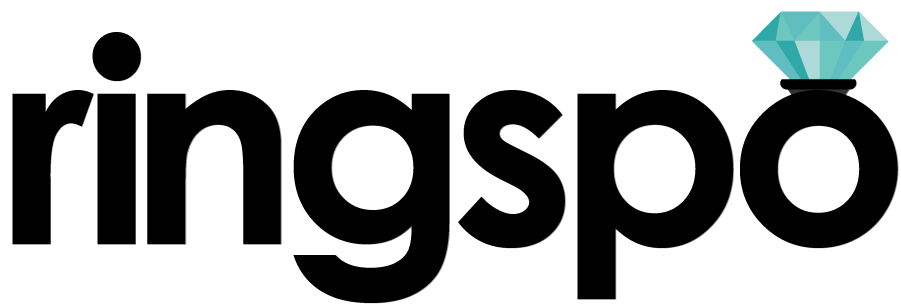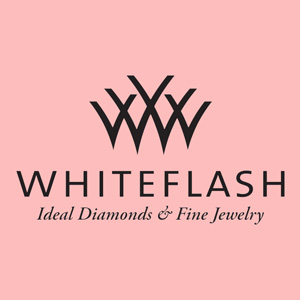Whiteflash Review
A cut above the rest?
Ringspo is reader supported
Ringspo is reader-supported, which means we may receive a commission if you click a link to a retailer & subsequently make a purchase.
We feature links to several retailers to help readers find the one that is the best fit for them. Find out more about how Ringspo works here.
Whiteflash is one of the original online boutique diamond sellers and is has retained its reputation for extremely high quality in producing and selecting diamonds. They are also one of the very few online stores that are authorized to sell designer engagement ring settings from Tacori, Verragio, Simon G, Ritani and Danhov.
If you are looking for a designer setting and the highest quality diamonds available then Whiteflash should be your first stop.
As with all my reviews, I’m going to break this down into four sections:
- Diamond Selection
- Ring Setting Selection
- Website Design and ease of use
- Customer Service
Diamond Selection
Diamonds at Whiteflash can be broken down into two main groups – their signature line, which are specially selected in accordance with strict criteria, and then a much larger group of diamonds in their ‘virtual inventory’, which are held by other organisations that they partner closely with.
One important thing about Whiteflash’s virtual selection is that they ensure that all diamonds come through the Whiteflash HQ in Houston to be checked and verified before being sent out to customers – they are never ‘dropshipped’ straight from the supplier to you, the customer.
In this section we’ll take a quick look at each of the different levels of Whiteflash’s signature diamond cuts and explain what the difference is between them.
The Whiteflash Diamond Range
- At the top of the tree is a range of diamonds called ‘A CUT ABOVE’. Although the name may be a bit shouty, they are among the very best diamonds offered anywhere in the world, so a bit of caps lock might be warranted.
- Below A CUT ABOVE sites the ‘Expert Selection’. These are diamonds which nearly made the grade for A CUT ABOVE (I’m just going to call them ACA from now on), but narrowly missed out.
- Below this is a range called ‘Premium Select’ which are less expensive and ‘offer more value’. Each of the diamonds in these ranges is physically held by Whiteflash.
- The remainder of the diamonds are part of the ‘virtual selection’, which means that they are held off-site by suppliers, rather than in Whiteflash’s own storage facilities.
So those are the four tiers of diamonds, but how do they compare? First off, I looked at the price for one example of each diamond which fit my standard review criteria:
- 1 carat
- VS2 Clarity
- F/G Color
- Ideal cut / Polish / Symmetry
The prices for the diamonds that I examined were:
A CUT ABOVE:
$9.638
Expert Selection:
$8,235
Premium Select:
none available at time of review
Virtual selection:
$6,878
As you can see, there’s a big difference between the price you would pay for an ACA diamond and a diamond that is held in the ‘virtual inventory’ which ostensibly has very similar stats on its grading report. Is this difference worth it? Let’s take a look.
Click the sections below to read detailed reviews about each of the types of stone that Whiteflash offers:
A CUT ABOVE
Whiteflash’s ACA take the top diamond cut requirements from the strictest independent gem grading lab – the AGSL and apply Whiteflash’s even more stringent selection policies on top of them.
So, while a GIA Excellent graded diamond can have a table width % of anywhere from 52%-62%, the ACA tolerances are much tighter and table width % must be within 53% – 58%.
| Measurements | GIA Excellent | A CUT ABOVE |
|---|---|---|
| Depth % | 58.6% – 62.9% | 59.5% – 62.0% |
| Table % | 52.0% – 62.0% | 53.0% – 58.0% |
| Crown Angle | 31.5° – 36.5° | 34.0° – 35.0° |
| Pavilion Angle | 40.6° – 41.8° | 40.6° – 40.9° |
Similar restrictions apply to all other angles and proportions of a diamond and these tight tolerances have been developed to rule out diamonds which only just squeeze in to ‘Excellent’ or ‘Ideal’ cut grades, but actually won’t perform particularly well optically and sparkle brilliantly.
Diamond cutters, who produce the finished gems, know what the tolerances are for the normal GIA or AGSL top cut grades, so often cut diamonds so that they just squeeze into those grades while retaining as much carat weight as possible.
Making the bottom half of a diamond (the pavilion) a fraction of a millimeter deeper may bump up the carat weight by 0.05 carats, making the table a fraction of a millimeter wider may add another 0.05 carats, so by combining both of these the cutter has added an extra 0.1 carat to the diamond carat weight. If they can do this but still stay just within the recommended excellent or ideal cut grade proportions then they can make a diamond more valuable, even if it actually performs less well than a diamond which is cut purely for light performance.
By only accepting diamonds within the sweet spot of each of the proportions of a diamond, Whiteflash are ensuring that none of the edge case excellent cut diamonds are included in their signature cuts
For every diamond in the ACA range, Whiteflash provide at least 4 images, which can be used to compare diamonds which to see which are . This can get technical, and any advantage to the level of sparkle that you will actually see once a diamond is mounted in a ring is subject to diminishing returns. All of the diamonds have been graded as top performers and subject to the very tight cut grading requirements above, so all should sparkle better than 99.9% of diamonds that are available on the market.
The images that are supplied with each diamond are:
- Magnified image of the diamond itself
- An Ideal scope image, which is used to show areas of light leakage (the less white visible, the better)
- An ASET image, which is used to show not only where light is leaking, but also the intensity of the light
- A ‘hearts’ image, looking from the bottom of the diamond (known as the pavilion), which shows the incredibly symmetrical hearts that are formed by the different facets (sides) of the diamond.
- Some diamonds also have a ‘glamor shot’ of the diamond, which show the fire and brilliance. Not especially useful for analysis of the stone, ut
Each of these can be used to help form an opinion on how well a diamond is going to perform and how brilliantly it is going to sparkle.
Holloway Cut Adviser
To begin with analysis, I’m going to look at the diamond using the Holloway Cut Adviser. This is an easy to use tool which is a tool developed by a diamond industry veteran which takes into account all of the angles of a diamond and uses an algorithm to determine:
- the level of light return (the proportion of light which is returned to your eye
- the fire (the mixed colours that a diamond produces)
- the scintillation (the level of sparkle), and
- how big the diamond looks compared to other diamonds with the same carat weight.
The Holloway cut adviser is a good tool to weed out diamonds which are graded highly for cut but which actually perform poorly. It takes into account how all the angles of a diamond work together to reflect light, rather than just judging on the quite broad proportion criteria of the standard ‘ideal’ or ‘excellent’ grade.
The results of the A CUT ABOVE test on the Holloway Cut Adviser can be seen below:
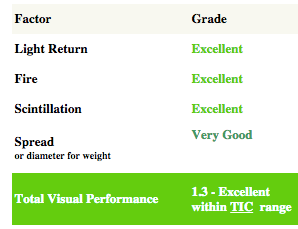
The diamond scores ‘Excellent’ on all aspects of the Holloway Cut Adviser, which is to be expected.
This stone has been selected precisely because its proportions and angles are close to the ideal proportions for a round brilliant diamond, so it is reasonable to expect that it would perform excellently.
However, it’s also good to have a theory confirmed through testing.

ASET image
ASET stands for ‘Angular Spectrum Evaluation Tool’ and although that sounds complicated, it’s basically a viewer which shows how much light leaks from a diamond and how much will be bounced back to the viewer in the form of brilliant sparkle.
It’s the best tool to determine how much a diamond is actually going to sparkle, and if you want a detailed intro to ASET and how to read the images, you can check out this blog. However, a quick guide to interpreting ASET images is:
- Red: the most intense light – as much red as possible is good.
- Blue: shows the contrast pattern of the diamond – this should be as symmetrical as possible.
- Green: light reflected at an angle, which gives low intensity. Some green is inevitable, but we want to reduce this as much s possible.
- Black: light leakage. We want to reduce this as much as possible. (Sometimes the light leakage shows as white)
Here’s a couple of example ASET images to show what good and bad ASET images look like:
Well-cut diamond:
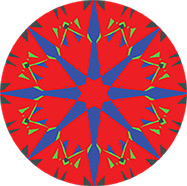
Majority is red (indicating light getting reflected) with small areas of low-intensity green and a distinct pattern of blue. The blue pattern resembles arrows, an indication of the symmetry of the diamond.
Poorly-cut diamond:
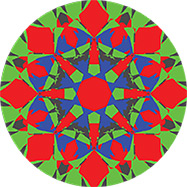
Although there is some red, the majority of the light is low intensity green and the dark areas show where light is being lost entirely. This diamond would appear dull and lifeless.
Our A CUT ABOVE diamond’s ASET results:
Comparing the ASET image from our Whiteflash ACA diamond on the right to the ‘ideal’ image above, we can see that the pattern of returned light is very similar.
The pattern of green (low-intensity) light is very similar and although there are some small areas of black (indicating lost light), this is well within the accepted amount.
One big difference is that the ACA diamond has green over the center of the diamond, while the example has red in the center.
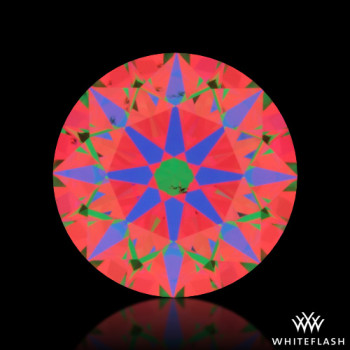
This is actually a quirk of the way that the ASET image: sometimes the center appears red and sometimes appears green, depending on the angles of the diamond. It isn’t an indicator that the diamond has low light intensity.
Idealscope Image
Similar to ASET images, Idealscope images are used to highlight areas of light leakage, but are also used to show the ‘hearts and arrows’ and judge a diamond’s level of symmetry.
Example Idealscope images:
Hearts:
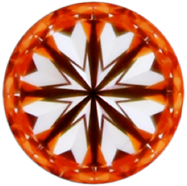
This image is taken looking at the bottom of the diamond (known as the ‘pavilion’). You can see that there’s excellent symmetry throughout: the hearts are the same size as each other and the gap between each heart and the V-shape underneath them is distinct (they shouldn’t touch) and identical.
Arrows:
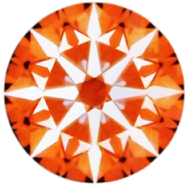
This image is taken looking at the top of the diamond. Each arrow head and the shaft should be perfectly aligned and the size of the arrow shafts and pointed tips should be uniform.
Our A CUT ABOVE’s Hearts:
Looking at our ACA diamond, we can see that eight hearts are all very equal, with squared off shoulders, which is what we are looking for.
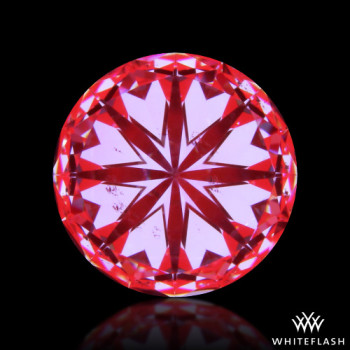
The Vs in front of the hearts are all very similarly- sized and the gap between the Vs and the hearts themselves are all very similar.
In short, this stone is exhibiting excellent hearts, indicating an incredible level of precision in the ut and symmetry.
Our A CUT ABOVE Diamond’s Arrows:
Conclusion
The high standards that are required to be classified as an A CUT ABOVE diamond means that not many stones make it. I chose the least expensive diamond that fit my standard size, colour and quality testing criteria and I’m extremely impressed with what I’ve found.
On every test, the ACA stone performed at the very highest level imaginable. If you are looking for the best of the best for your diamond, then Whiteflash A CUT ABOVE is definitely it.
Expert Selection
The Whiteflash Expert selection is a range of stones that narrowly missed out on becoming an ACA stone. Their angles and proprtions don’t quite fit into the narrow band required by ACA, but they still fit into a stricter requirement than the regular GIA Excellent or AGSL Ideal cut grade.
How goes it compare to the ACA? Let’s find out.
Holloway Cut Adviser
First off the Holloway cut adviser results. The Expert selection stone scores also Excellent across the board for all light return, fire and scintillation.
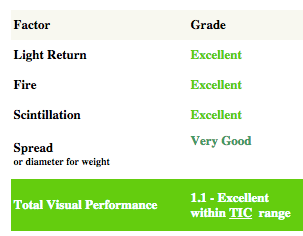
It actually scores lower than the ACA diamond, although this doesn’t necessarily mean that it will perform better than the ACA. The Holloway Cut Adviser is primarily useful to just filter out bad diamonds, so this has simply shown us that both the ACA and the Expert Selection are good stones, which is to be expected as they have been hand-picked.
Looking at the other images and it is clear why this stone didn’t quite make the ACA.
Hearts and arrows:
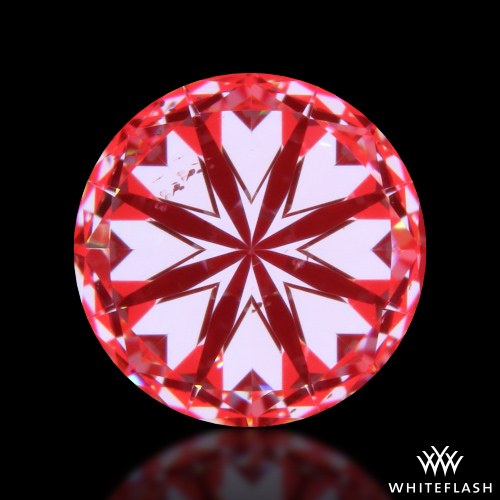
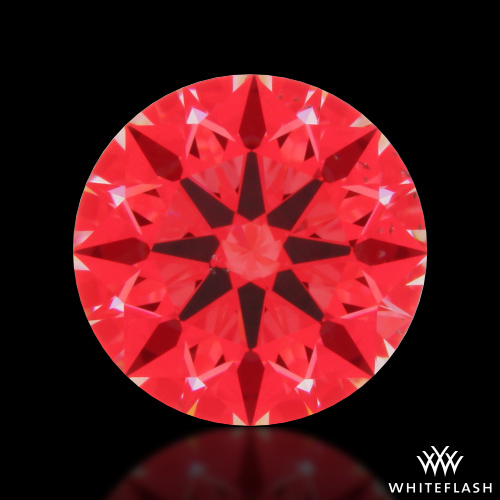
The hearts and arrows look good, although not quite as good as the ACA stone that we looked at above.
On the hearts image, the arrow heads in front of the hearts aren’t all equal and aren’t equal distances away from the hearts behind them.
In the arrows images, some of the heads of the arrows are separate from the shafts of the arrows.
These are very, very minor points though and as there is not fixed definition of what a hearts and arrows diamond is, this stone would still fit within the description in my opinion.
ASET
Looking at the ASET image, two areas of light leakage can be seen on the right of the image.
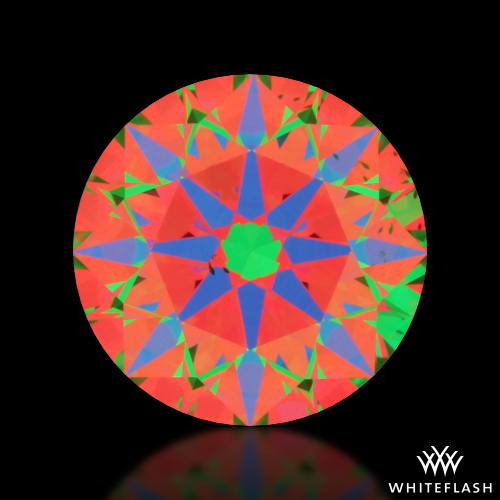
While the rest of the diamond looks comparable to the ACA diamond, this area indicates that the cut is not quite as symmetrical as the ACA and it is possible that there may be less brilliant sparkle from this area of the stone.
When mounting the diamond into a ring setting, the jeweler will be aware of this area and is likely to cover it with the prong of the ring setting, which would mean that the effect of the light leakage is greatly reduced.
Conclusion
If you are looking for the very best of the best then the ACA diamond is closer to a ‘perfect’ diamond than the Expert Selection. The two areas of light leakage on the right side of the stone mean that some people may feel like this stone is compromised slightly.
However, the Expert selection is an incredibly well cut diamond which still has an AGS ‘Ideal’ cut grading and performs exceptionally well on the Holloway Cut Adviser. If mounted well, with a prong covering the areas of light leakage, the Expert Selection would be virtually indistinguishably brilliant from the ACA diamond, while benefitting from a significantly lower cost.
Virtual Selection
Lastly, we’ll take a quick look at the Virtual selection diamond. There is a much greater choice of virtual selection stones on the Whiteflash site, but I chose one at random to review which matched the specs of the ACA and Expert Selection.
This stone is graded as Excellent Cut by the GIA and has Excellent symmetry and polish, like the ACA and Expert Selection. However, it has not been personally reviewed by Whiteflash’s gemologists and it doesn’t fit into their stricter cut criteria.
No ASET or Idealscope images are available for Virtual Selection diamonds, so the only tool that we have to assess the diamond’s performance is the Holloway Cut Adviser:
Holloway Cut Adviser
Looking at the results on the right, we can see that the Virtual Selection scores much lower than both the ACA and the Expert selection stone. While they both received a score under 2.0 (which should be the cut off for accepting a stone), the Virtual Selection diamond scores 4.8 and the results indicate that while it is’t a terrible performance, this diamond won’t sparkle particularly brilliantly.
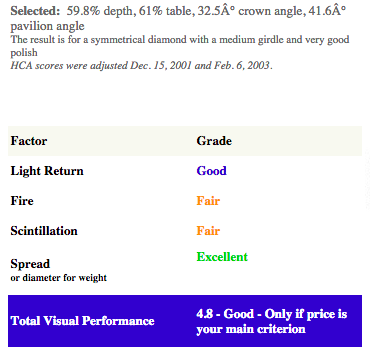
This is where the Holloway cut adviser tool is really useful. This diamond was graded as ‘Excellent’ by the GIA, but doesn’t perform excellently.
Conclusion
With a score of 4.8 on the Holloway Cut Adviser, I’d recommend rejecting this stone and continuing to search for a stone until a score of under 2.0 is found.
This is no reflection on Whiteflash themselves at all – this is a stone that has been graded at the highest grade by one of the most trusted labs (GIA) and is likely to also be available on several other retailers’ websites also.
This is not to say that all Virtual Selection stones will be bad though. A shortcut to find a high performing Virtual Selection stone would be to apply the depth % and table % from the A CUT ABOVE stats above to the advanced settings on the Whiteflash search tool and then test those stones on the Holloway Cut Adviser. In this way, you should be able to find a stone with proportions which are better suited to reflect as much light as possible back to your eye and sparkle brilliantly.
Ring Settings
Where Whiteflash differs from many of my other recommended retailers is in the selection of engagement ring settings that it offers.
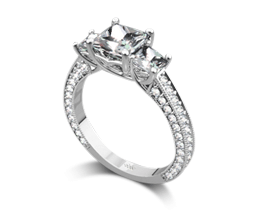
While classic and somewhat standard styles of solitare, halo and three ring settings are on offer, Whiteflash also offers a wide range of ornate designer rings from manufacturers that are difficult to find from other online stores.
This is a huge boon if you are looking for a designer setting from Tacori, Verragio or Ritani but want the very highest quality diamond set in it – you can team it with either an A CUT ABOVE or Expert Selection stone.
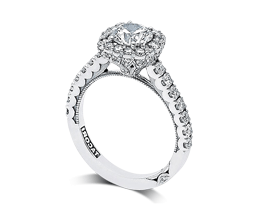
As a result of this, Whiteflash has one of the widest ranging and most interesting selections of engagement ring setting styles anywhere on the web.
Custom Rings
If you can’t find the ring setting that you’re looking for from either the standard settings range or within the designer range, Whiteflash also have a full custom design service available. If you’ve seen several rings that you like and want to combine the best features of each of them, then Whiteflash’s custom service is perfect for this.
One thing that Whiteflash is adamant about is that they won’t just copy another designer’s ring design, which would breach copy right laws and just generally be unethical. The fact that Whiteflash take this stance so firmly is indicative of the general honest nature of the company – something that not all jewelers adhere to.
Website
Whiteflash have just relaunched their website and it is now extremely easy to use and packed full of excellent educational information.
Whiteflash’s position as a retailer of the very highest quality of diamonds is , as they provide detailed information about what it is that makes their ‘A cut above’ range so exceptional, as well as sharing their grading process in detail that can’t be found anywhere else on the internet. This information is only really interesting or useful if you really want to get into the detail about diamonds and what it is that you are paying a premium for, but if that describes you then pages like this one which details how a ‘hearts and arrows’ diamond is selected are excellent.
Using the Whiteflash site to find the diamond that is right for you is easy, with an efficient diamond search tool that allows you to restrict your search to only ACA, Expert selection or virtual selection stones if you know that these are what you are looking for.
The diamond detail pages include all of the images that you need to make a decision on each stone and there are also clear icons to show the which category the diamond sits under, the grading authority and whether the stone has been judged to be eye clean by Whiteflash staff.
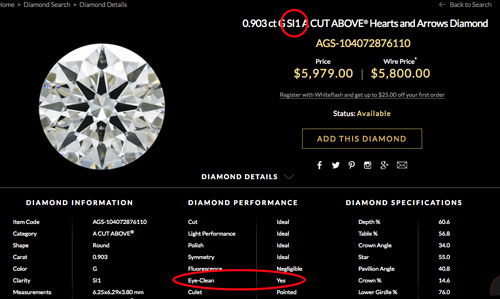
Some diamonds don’t say ‘yes’ in the eye clean column, but say ‘inquire’ instead. This doesn’t necessarily mean that they would not be perceived to be ‘eye clean’ by the vast majority of people. Instead, they are a reflection of Whiteflash’s commitment to transparency and ensuring that customers get the diamond that is right for them.
Whiteflash’s test of whether a diamond is eye clean is whether any inclusions are visible at a distance of 8-10 inches in normal lighting. A keenly-trained gemologist’s eye will pick up inclusions much more easily than a layman, especially once a diamond has been placed in a ring setting.
For stones that have been ‘Inquire’ at the, the Whiteflash team can describe the nature of the inclusions to customers, giving them a much better picture of what is visible, how visible it is and from which directions and distances. In this way they can better determine if the diamond is right for them.
If there is a stone that you like at Whiteflash which has ‘Inquire’ in the eye clean column, I would recommend that you contact them to discuss the severity of the inclusions and see whether it could actually be a great choice for you.
Service
Pre Purchase
As with most of my other recommended retailers, Whiteflash offers 24/7 chat with customer service agents, who are all GIA qualified. They’re able to answer pretty much any question you throw at them about a diamond that you’re looking at, but if you pitch them an absolute curveball then they may refer the question to one of their in-house gemologists and get back to you with an answer over email.
If you have found a diamond that you love but you’re not quite ready to pull the trigger immediately then you can place the diamond on reserve for 24 hours by emailing or talking to one of the customer service team. I would definitely recommend doing this. It’s not something that all retailers offer, but there is nothing more frustrating than finding a great diamond and then going back the next day to buy it and finding that someone has stolen it away from under your nose
Purchase
For purchases within the USA and Canada, Whiteflash accept credit cards, PayPal and Bank Wire Transfer with a discount offered for Wire transfer. While most of my other recommended retailers offer a 1.5% discount for payment by wire transfer, Whiteflash offers a whopping 3%, which is definitely not to be sniffed at.
When you purchase your ring, Whiteflash will aim to send it out to you as quickly as possible. For diamonds that they have on-site, this can be as quickly as the same day that you order. For diamonds from the ‘virtual selection’ which are held by other companies, this can take a couple of days for the diamond to be shipped to Whiteflash, inspected and then mounted in a ring. Either way, this is an extremely fast turnaround and the slight delay in the shipping of the virtual
Each finished ring has a high quality image taken of it which is supplied to the buyer, similar to the images shown in the testimonials page on the Whiteflash site.
Each ring is then shipped in a high quality cherrywood box with a Whiteflash logo on the inside of the lid. Almost all ring retailers seem to emblazon their logo on the inside of the lid and some do it better than others. Whiteflash’s logo is pretty unobtrusive and the box and is definitely worthy of use for the big question itself.
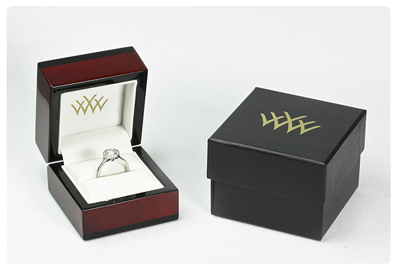
Shipping of within the US rings is by Fedex , fully insured and with a tracking number provided for payments made by wire transfer. For the shipping of rings that were paid for by credit card, no tracking number is available. This is because
Buying from outside the US
Whiteflash isn’t quite as friendly to purchases from outsite the US as most of my other recommended retailers. Prices can only be displayed in US$ and for all purchases from outside the USA and Canada, Whiteflash only accepts payment by bank wire transfer. Although this isn’t an impossible hurdle to overcome it, is definitely more hassle than just typing in credit card details.
One nice feature that Whiteflash do offer their international customers though is a widget for calculating shipping and tax for each country that they ship to. Shipping of rings outside the US is $50 plus 1% of the value of the order e.g. if an engagement ring is priced at $7,500.00, shipping will be $50 + $75 (7500 x .01) = $125 total. Many competitors offer completely free international shipping, so if you’re tossing up a purchase between Whiteflash and a competitor, then this is something to factor into your equation.
This is another factor which makes buying from Whiteflash less appealing if you are outside the US, but if you are looking for a top quality diamond and have your heart set on one of the A CUT ABOVE or Expert Selection diamonds then this shouldn’t put you off.
Post Purchase
If you change your mind, Whiteflash offer two levels of moneyback guarantee. For the stones that they hold in stock (A CUT ABOVE, Expert Selection and Premium Select), Whiteflash offers a full 30-day money back guarantee.
Diamonds from Whiteflash’s Virtual Selection are covered by only a 10 day money back guarantee from the day that you receive the diamond.
Jewelry that is custom made or altered from original specifications (other than normal sizing) are not returnable.
The 30 day moneyback guarantee is pretty standard amongst all my recommended retailers, but the 10 day moneyback guarantee is very tight indeed. If you think that you can work within this then the high level of service from Whiteflash and settings and the premium settings that they offer may mean that it is worth. However, it is definitely something to factor into such a large purchase.
Whiteflash are also comitted to looking after their customers after a purchase in other ways too. Any in-house certified diamond qualifies for a ‘100% Lifetime Trade Up Guarantee’. This means that you can trade in a Whiteflash diamond at any time for any other in-house diamond of equal or greater value for the full purchase price, which is pretty incredible.
Or, if you just need to return your diamond after the initial 30 day return period, Whiteflash will buy qualifying diamonds back at 70% of the diamond’s purchase price for one year from the invoice date. Again, this is a great service that goes above and beyond what many retailers are prepared to offer.
Whiteflash Rating
Overall, Whiteflash is an excellent choice if you’re looking for the very highest quality round brilliant or Princess cut diamond. There are very few jewelers on- or offline who can match them for their range of top quality stones, and the excellent information provided to make sure that you can make a truly informed decision and get the very best stone available.
And if you’re looking for a designer engagement ring setting, then there are few jewelers out there who can match their range of designer names all in one place. They have a huge variety of styles available, as well as the ability to create a custom ring setting
Where Whiteflash falls down slightly is in their ease of ordering from outside of the US and their returns policy for ‘virtual selection’ diamonds. These are relatively minor quibbles though as the virtual selection isn’t really where Whiteflash’s strength lies.
Instead, Whiteflash is the premier choice for those who want the very highest quality stone from one of Whiteflash’s signature collections, tied to personable and attentive service to ensure that each buyer gets the ring that is right for them.

